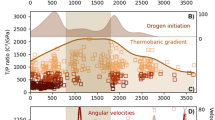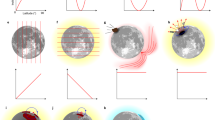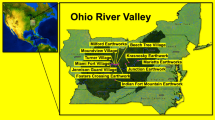Abstract
INTEREST in the hypothesis that the Earth's radius has increased during geological history has been renewed in recent years because of several sets of independent observations and interpretations. From studies of the deformation of mountain ranges and the distribution of faults and oceans, Carey1 proposes an increase in the Earth's area of 45 per cent since the Palæozoic era. Heezen2 similarly interprets submarine topography as indicating that the oceans may be immense rift valleys formed by a pulling apart of the continents as the Earth expanded. Using a different approach, Egyed3,4 infers a rate of increase of the Earth's radius of 0.4–0.8 mm. per year. This calculation is based on a decrease in the total amount of continental area covered by oceans during the past 400 million years, as determined palæographically. Egyed4 has also pointed out the desirability of using palæomagnetic data to test this hypothesis.
This is a preview of subscription content, access via your institution
Access options
Subscribe to this journal
Receive 51 print issues and online access
$199.00 per year
only $3.90 per issue
Buy this article
- Purchase on Springer Link
- Instant access to full article PDF
Prices may be subject to local taxes which are calculated during checkout
Similar content being viewed by others
References
Carey, S. W., “Continental Drift”, Symp. Univ. Tasmania, 177 (1958).
Heezen, B. C., Internat. Oceanog. Cong., preprints, edit. by Sears, M., 26 (1959).
Egyed, L., Nature, 178, 534 (1956).
Egyed, L., Geofisica Pura e Applicata, 45, 115 (1960).
Gusev, B. V., Informatsionnyy Byulleten Instituta geologii arktiki Leningrad, 4, 30 (1959); Inter. Geol. Rev., 2, 327 (1960).
Hospers, J., Nature, 173, 1183 (1954).
Creer, K. M., Phil. Trans. Roy. Soc., A, 250, 111 (1957).
DuBois, P. M., “Adv. in Phys.”, 6, 177 (1957).
Roche, A., C.R. Acad. Sci., Paris, 244, 2952 (1957).
Rutten, M. G., van Everdingen, R. O., and Zijderveld, J. D. A., Geol. en Mijnb., N.S., 19e Jaarg., 6, 193 (1957).
As, J. A., and Zijderveld, J. D. A., Roy. Astro. Soc. Geophys. J., 1, 102 (1958).
Armstrong, D., Nature, 180, 1277 (1957).
Nairn, A. E. M., Géol. Soc. France Bull., Ser. 6, 7, 721 (1957).
Nairn, A. E. M., J. Geol., 68, 285 (1960).
Kulp, J. L., Internat. Geol. Cong. Copenhagen, Rep. Twenty-first Session, Norden Pt. 3, 18 (1960).
Fisher, R. A., Proc. Roy. Soc., A, 217, 295 (1953).
Author information
Authors and Affiliations
Rights and permissions
About this article
Cite this article
COX, A., DOELL, R. Palæomagnetic Evidence Relevant to a Change in the Earth's Radius. Nature 189, 45–47 (1961). https://doi.org/10.1038/189045a0
Issue Date:
DOI: https://doi.org/10.1038/189045a0
This article is cited by
-
The evolution model of the earth’s limited expanding
Chinese Science Bulletin (2000)
-
Some similarities of expansion phenomena in the vicinity of the earth and in the universe as a whole
Astrophysics (1995)
-
An Expanding Earth?
Nature (1965)
-
The Expanding Earth?
Nature (1963)
-
Palæomagnetic Indications of an Increase in the Earth's Radius
Nature (1963)
Comments
By submitting a comment you agree to abide by our Terms and Community Guidelines. If you find something abusive or that does not comply with our terms or guidelines please flag it as inappropriate.



